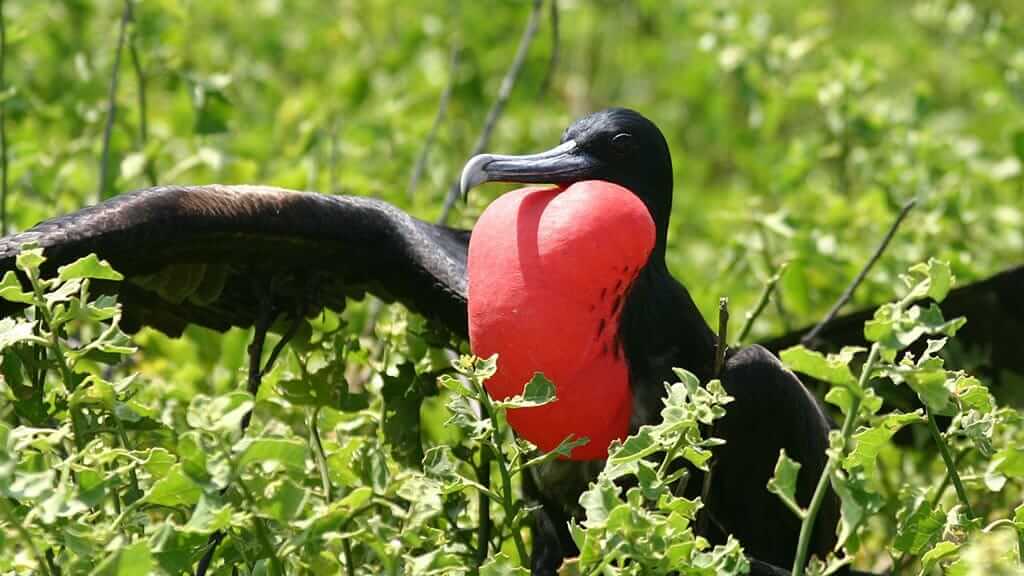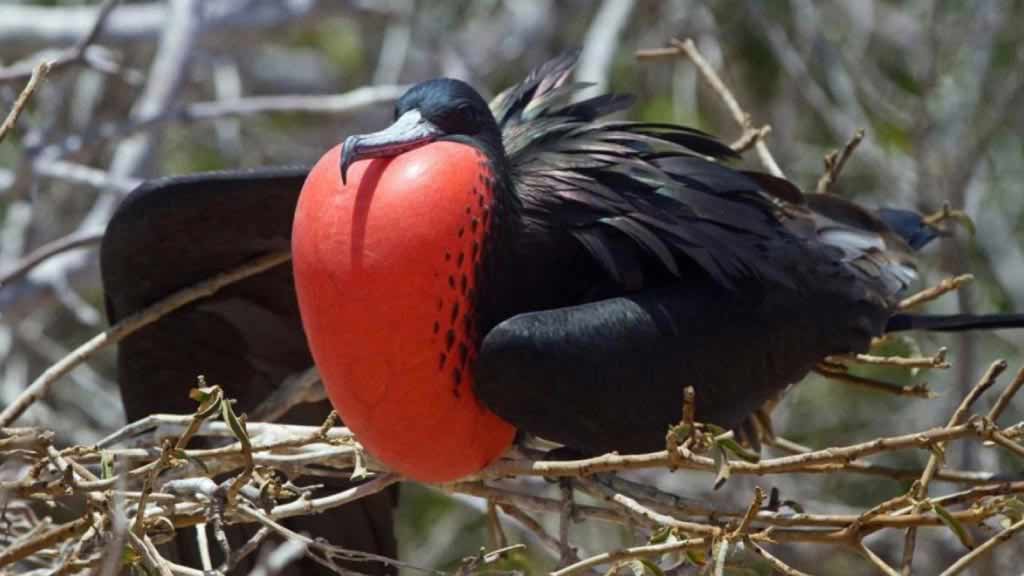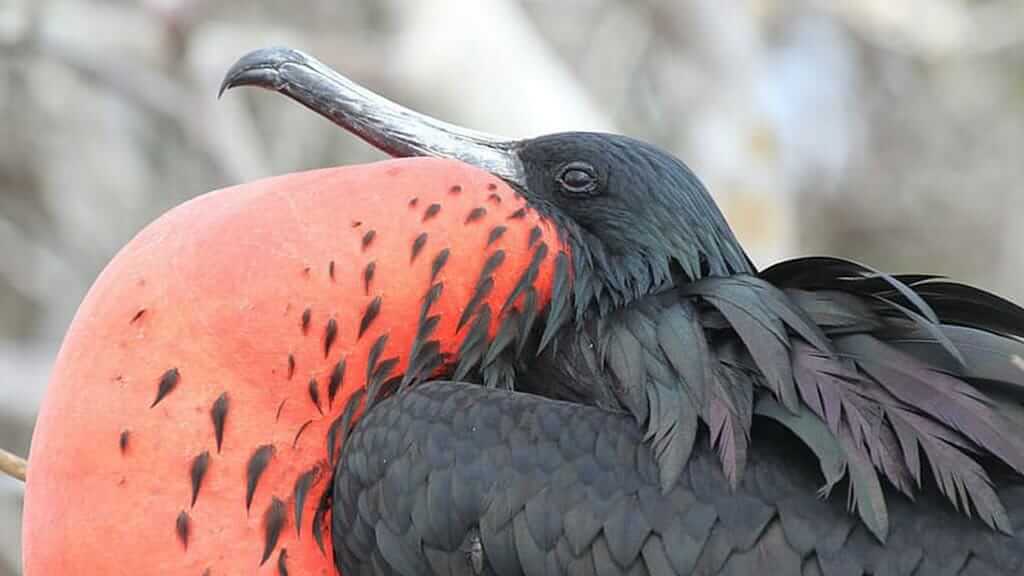GALAPAGOS FRIGATE BIRD
The Galapagos Frigate bird is unmistakable as it soars like a prehistoric Pterodactil across blue Galapagos skies. Although Frigates are not endemic to Galapagos, they do live here in large numbers. For many visitors this is a first sighting of Frigate birds, so you are in for a treat. Not only do they love to follow tourist yachts out to sea, they’ll sometimes even perch atop the captains deck. The real highlight though is to spot a Galapagos Frigate bird in mating season, with his red throat pouch puffed out dramatically. This is one of the archetypal images of the Galapagos Islands, and makes for amazing photos and memories to take home with you.
Read on for everything you need to know about the Galapagos Frigate bird. Where and when to see them? Plus lots of fun frigate bird facts and information.
Frigate Bird Conservation Status: Least Concern
Scientific Name: Fregata Magnificens (Magnificent Frigate Bird) / Fregata Minor (Great Frigate Bird)
How to See a Galapagos Frigate Bird?
Where to find them:
The Galapagos Frigate bird is a guaranteed sighting during any Galapagos cruise or land trip. They can be spotted right across the archipelago, especially in areas where other sea bird species nest. Just look to the skies and they are usually gliding around, silhouetted against the sky. The real deal though is to see them on land at a Frigate bird nesting site. The largest nesting Frigate colonies are found on North Seymour (especially the Magnificent Frigate Bird), Floreana, San Cristobal and Genovesa islands. These are the best places at Galapagos to see a male Frigate bird with his impressive red throat pouch.
When to see them:Frigate birds live at the Galapagos islands all year round. Breeding and nesting seasons, however, vary by island. On Genovesa and San Cristobal the best months to see frigate bird pouches is from March to May. While on North Seymour mating begins a little later in June. Contact us for a FREE GALAPAGOS TOUR QUOTE, or for more information to organise your Galapagos vacation to see Galapagos Frigate birds.
GET FREE ADVICE
From a Galapagos destination expert todayEverything you need to know about Galapagos Frigate Birds
Frigate Bird Appearance
Frigate birds are unique in appearance and easy to identify. They are large sea birds, black in color with forked tail and long curved beak. The male frigate has a red throat pouch. During mating season this gular sac is spectactularly inflated like a balloon. For the rest of the year it is visible as a small red sac hanging from his throat. Females can be identified by their white undercarriage, and colored eye ring.
The Galapagos Islands are actually home to two different Frigate bird species: the Great Frigate bird & the Magnificent Frigate bird. At first sight they may appear the same, but on closer inspection there are subtle differences to tell them apart. The Magnificent Frigate bird is slightly the larger of the two. The sheen of their plumage also differs – a green sheen for the Great versus a purple iridescence for the Magnificent. With female it is easier to tell them apart due to the different colored eyerings – red for Great, blue for Magnificent.
Galapagos Frigate Bird Behavior
Frigate bird nests are made of twigs, built in low shrubs by the male bird. Once the nest is ready, the male needs to attract a female to share the new home. This is no easy feat as competition is fierce, and females can be rather picky. Each male bird inflates his bright red throat sac with air, literally like a balloon. He will then spread his wings, and points his head to the sky while clattering his bill. Meanwhile a female will circle overhead, carefully assessing her options. She can take her time, and usually has many potential suitors. When she sees something that she likes – a particularly goodlooking male, or a well made nest – she will fly down to join her chosen sweetheart.
A single egg is laid, and hatchlings are cared for first by the male for three months, then by the female for a further nine months. This is the longest stretch of parental care known in the bird world!
Frigate Bird Diet
Galapagos Frigate birds prefer a diet of squid, fish, jellyfish and crabs. They will also prey on hatching sea turtles as they make their way to the sea. Due to their effortless flying technique they actually require little in way of nutrients, and can go months without feeding.
Frigates have a very small preening gland, so they can’t secrete enough oil to keep their feathers waterproof. This makes hunting a challenge as they cannot dive underwater. Wetting their wings could cause them to drown. For this reason, the Galapagos Frigate bird has devised an intelligent method to hunt. They fly high observing while other sea birds dive for food. When they see that a Booby (for example) has made a catch, they swoop into action to steal an easy meal. They harass the poor sea bird until it releases the fresh catch, and then use their hooked bill to snatch the food up. This method may not make them popular, but it is mighty effective.
Frigate Bird Conservation at Galapagos
The Galapagos Frigate Bird is listed with a conservation status of “Least Concern“. There are no current conservation projects underway. They do, however, receive the same protection rights as all other species within the Galapagos Marine Reserve.
Fun Galapagos Frigate Bird Facts
• The Galapagos Frigate bird was nicknamed the Pirate bird or Man-o-War bird by the Spanish, thanks to their cheeky habit of stealing food from other bird’s mouths. Frigates are known to chase other species such as Tropicbirds or Boobies, catching them by the tail and shaking them until they regurgitate their recently caught food, giving the Frigate an easy meal.
• Frigate birds have the largest wingspan to body weight ratio of any bird on the planet, making them skilled and efficient gliders. The Magnificent Frigate bird clocks in with a wingspan of up to 114cm, and the Great Frigate up to 105cm.
• Galapagos Frigate birds have been tracked flying without rest for an incredible 56 days! How is this possible? They are able to glide with minimal effort on warm air currents, without even needing to flap their wings for hours or days at a time, sometimes even soaring to heights of several miles high. Using this efficient technique they can average an impressive 260 miles of flight per day.
• Frigate’s are able to sleep using only half of their brain, meaning that they are capable of sleeping even while in the air!
If you enjoyed this post, then check out more information about Galapagos Bird species.
Book With The #1 Trusted
Galapagos Travel Agency
The Galapagos Frigate bird is a guaranteed sighting at the islands. But don’t just tick it off of your wildlife bird list. Take time to observe the behavior of this wonderful species. They are majestic and gracefully effortless flyers. The Frigate bird mating ritual is a must-see for bird lovers. Even their cheeky habit of stealing food is a sight to behold. We challenge you, by the end of your trip, to be able to identify between a Magnificent and Great frigate bird. Good luck.





